How to uninstall The PC Power from operating systems
Potentially unwanted applicationAlso Known As: The PC Power potentially unwanted application
Get free scan and check if your device is infected.
Remove it nowTo use full-featured product, you have to purchase a license for Combo Cleaner. Seven days free trial available. Combo Cleaner is owned and operated by RCS LT, the parent company of PCRisk.com.
What is The PC Power?
The PC Power is software endorsed as a system cleaner and optimizer. It is allegedly capable of freeing up storage space, detecting and removing unnecessary files, malware, spyware, adware, and other threats/issues. Due to its dubious proliferation methods, it is categorized as a Potentially Unwanted Application (PUA).
The PC Power has a promotional website, from which a trial version can be downloaded free of charge and the full version purchased, however, it can also be inadvertently installed together with other programs. This deceptive marketing tactic of pre-packing regular software with unwanted content is called "bundling".
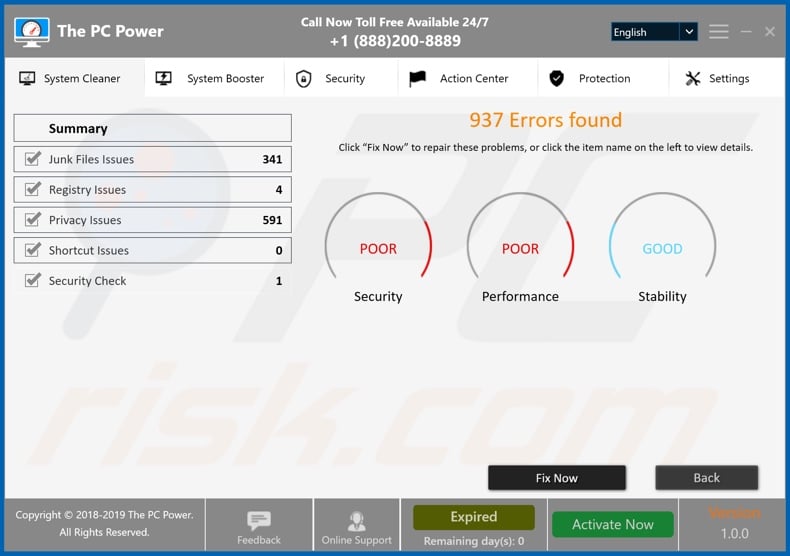
The PC Power is untrusted and classified as a PUA. Software falling within the this category is a potential threat to device and user safety. You are strongly advised against downloading/installing The PC Power. Most unwanted apps of this type require activation (i.e., must be purchased to become operational), however, in most cases, they are fake and nonoperational.
Therefore, even if they are activated (purchased), they remain nonfunctional and cannot perform the promised capabilities/features. Additionally, the download/installation set-ups used to proliferate apps such as The PC Power often contain more than one PUA (e.g. browser hijackers or adware).
These apps have many harmful capabilities. They can generate redirects to sale-based, untrustworthy, compromised, deceptive/scam, and malicious websites. Some can run intrusive advertisement campaigns by employing various tools that enable third party graphical content to be displayed on any site.
In this way, they deliver ads (pop-ups, banners, surveys, coupons, etc.) that severely diminish the browsing experience by limiting browsing speed and page visibility. Furthermore, intrusive ads carry certain risks by causing rogue redirects and unauthorized downloads/installs.
PUAs commonly track browsing-related data. They monitor users' browsing habits (URLs visited, pages viewed, search engine history, etc.) and collect personal information (IP addresses, geolocations, and other details). This sensitive data is then shared with third parties (potentially, cyber criminals) intent on misusing it for financial gain.
To summarize, PUAs can cause browser and system infiltration/infections and lead to serious privacy issues, financial loss, and even identity theft. To ensure device integrity and user safety, remove all suspicious applications and browser extensions/plug-ins immediately upon detection.
| Name | The PC Power potentially unwanted application |
| Threat Type | PUP (potentially unwanted program), PUA (potentially unwanted application). |
| Supposed Functionality | It supposedly operates as a system cleaner and optimizer. |
| Detection Names | Avast (Win32:Malware-gen), BitDefender (Application.Deceptor.ABX), ESET-NOD32 (A Variant Of MSIL/AKick.D Potentially Unw), Kaspersky (Hoax.Win32.DeceptPCClean.kfo), Full List Of Detections (VirusTotal) |
| Symptoms | A program that you do not recall installing suddenly appeared on your computer. A new application is performing computer scans and displays warning messages about 'found issues'. Asks for payment to eliminate the supposedly found errors. |
| Distribution Methods | Deceptive pop-up ads, free software installers (bundling), fake Flash Player installers. |
| Damage | Monetary loss (unnecessary purchase of fake software), unwanted warning pop-ups, slow computer performance. |
| Malware Removal (Windows) |
To eliminate possible malware infections, scan your computer with legitimate antivirus software. Our security researchers recommend using Combo Cleaner. Download Combo CleanerTo use full-featured product, you have to purchase a license for Combo Cleaner. 7 days free trial available. Combo Cleaner is owned and operated by RCS LT, the parent company of PCRisk.com. |
PUAs share many common features and those released by the same designers are often identical. PC Power Plus, Auto System Care, and Auto PC Care are just some examples of apps similar to The PC Power. They may seem legitimate and entice users to install by offering "useful" and "beneficial" features.
These features rarely work as advertised and are usually nonfunctional. The only purpose of this unwanted content is to generate revenue for the developers. Regular users receive no value. PUAs cause redirects, hijack browsers, deliver intrusive ad campaigns, and gather private data.
How did potentially unwanted applications install on my computer?
Some PUAs (including The PC Power) have "official" download web pages, on which they are typically promoted as "free" and "useful" software. They can also be unintentionally downloaded/installed together with other programs. "Bundling" is the term that describes this deceptive marketing technique of packing normal software with unwanted or malicious content.
Rushing download/installation processes (e.g. ignoring terms, skipping steps, etc.) increases the risk of allowing deceptive or bundled programs onto systems. PUAs also proliferate via intrusive ads. Once clicked, these can execute scripts designed to download/install PUAs without users' consent.
How to avoid installation of potentially unwanted applications
Research all content to verify its legitimacy, before downloading/installing. Use only official and verified download channels. P2P sharing networks (BitTorrent, eMule, Gnutella, etc.), free file-hosting sites, third party downloaders and similar sources are untrusted and should not be used.
Treat download/Installation processes with caution. Read the terms, study all available options, use the "Custom/Advanced" settings, and opt-out of downloading/installing additional apps, tools, features, etc. Intrusive ads often seem legitimate and innocuous, however, they redirect to dubious websites (e.g. gambling, pornography, adult-dating, and others).
If you encounter ads/redirects of this kind, inspect the device and remove all dubious applications and/or browser extensions/plug-ins. If your computer is already infected with PUAs, we recommend running a scan with Combo Cleaner Antivirus for Windows to automatically eliminate them.
Appearance of The PC Power application (GIF):
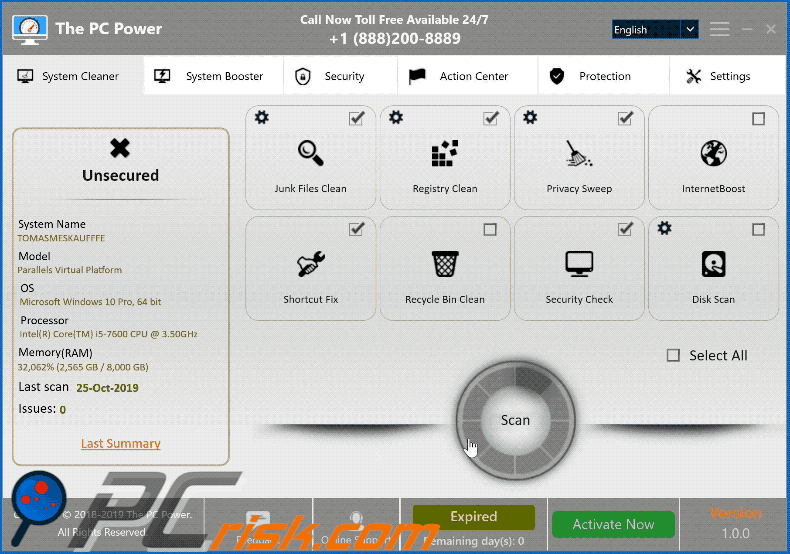
The PC Power installation setup:
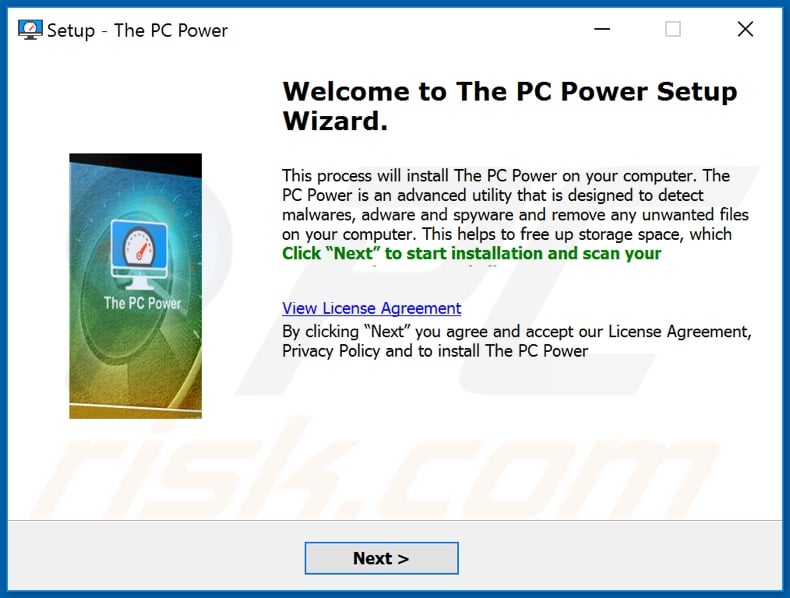
The PC Power urging users to activate it:
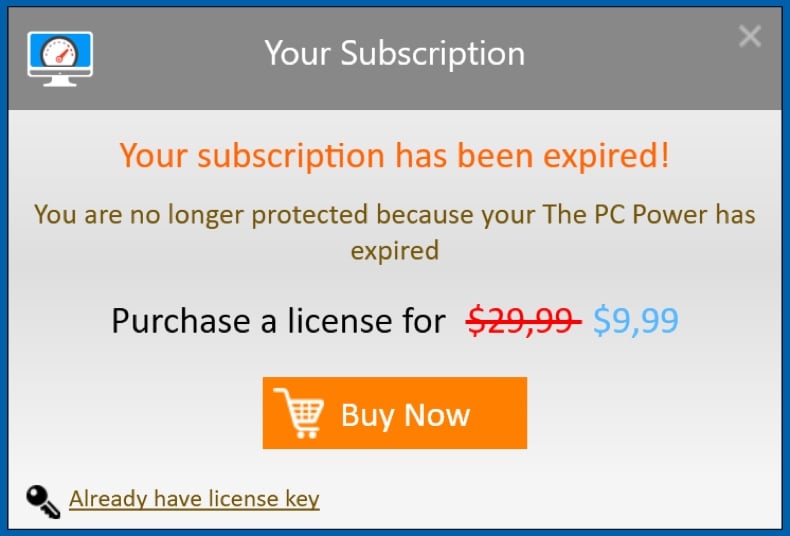
Website promoting The PC Power application:
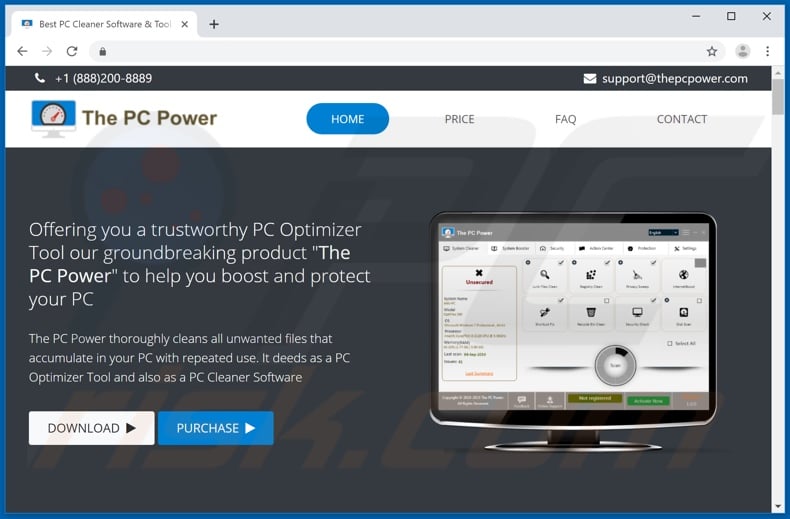
Instant automatic malware removal:
Manual threat removal might be a lengthy and complicated process that requires advanced IT skills. Combo Cleaner is a professional automatic malware removal tool that is recommended to get rid of malware. Download it by clicking the button below:
DOWNLOAD Combo CleanerBy downloading any software listed on this website you agree to our Privacy Policy and Terms of Use. To use full-featured product, you have to purchase a license for Combo Cleaner. 7 days free trial available. Combo Cleaner is owned and operated by RCS LT, the parent company of PCRisk.com.
Quick menu:
- What is The PC Power?
- STEP 1. Uninstall deceptive applications using Control Panel.
- STEP 2. Remove malicious plug-ins from Internet Explorer.
- STEP 3. Remove rogue extensions from Google Chrome.
- STEP 4. Remove potentially unwanted plug-ins from Mozilla Firefox.
- STEP 5. Remove rogue extensions from Safari.
- STEP 6. Remove rogue plug-ins from Microsoft Edge.
Removal of potentially unwanted applications:
Windows 11 users:

Right-click on the Start icon, select Apps and Features. In the opened window search for the application you want to uninstall, after locating it, click on the three vertical dots and select Uninstall.
Windows 10 users:

Right-click in the lower left corner of the screen, in the Quick Access Menu select Control Panel. In the opened window choose Programs and Features.
Windows 7 users:

Click Start (Windows Logo at the bottom left corner of your desktop), choose Control Panel. Locate Programs and click Uninstall a program.
macOS (OSX) users:

Click Finder, in the opened screen select Applications. Drag the app from the Applications folder to the Trash (located in your Dock), then right click the Trash icon and select Empty Trash.
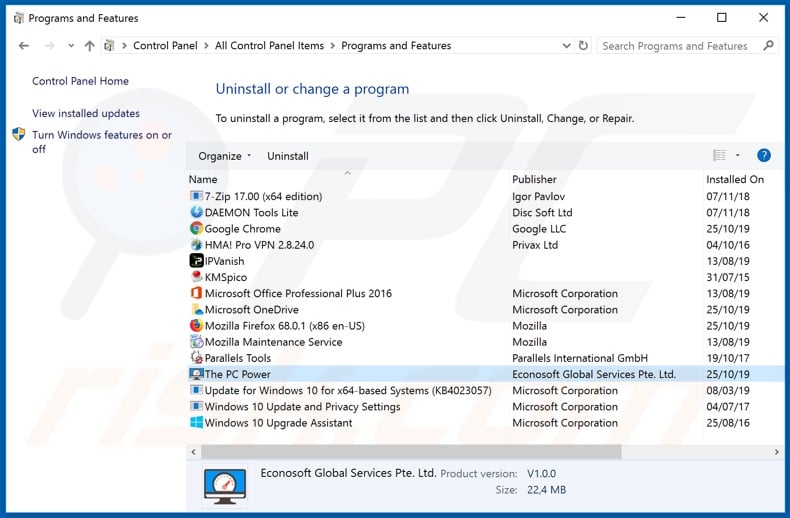
In the uninstall programs window, look for "The PC Power" and other suspicious/recently-installed applications, select these entries and click "Uninstall" or "Remove".
After uninstalling the potentially unwanted application, scan your computer for any remaining unwanted components or possible malware infections. To scan your computer, use recommended malware removal software.
DOWNLOAD remover for malware infections
Combo Cleaner checks if your computer is infected with malware. To use full-featured product, you have to purchase a license for Combo Cleaner. 7 days free trial available. Combo Cleaner is owned and operated by RCS LT, the parent company of PCRisk.com.
Remove rogue extensions from Internet browsers:
At time of research, The PC Power did not install any unwanted browser extensions, however, some unwanted applications can be installed together with adware and browser hijackers. If you experience unwanted ads or redirects when browsing the internet, continue with the removal guide below.
Video showing how to remove potentially unwanted browser add-ons:
 Remove malicious add-ons from Internet Explorer:
Remove malicious add-ons from Internet Explorer:
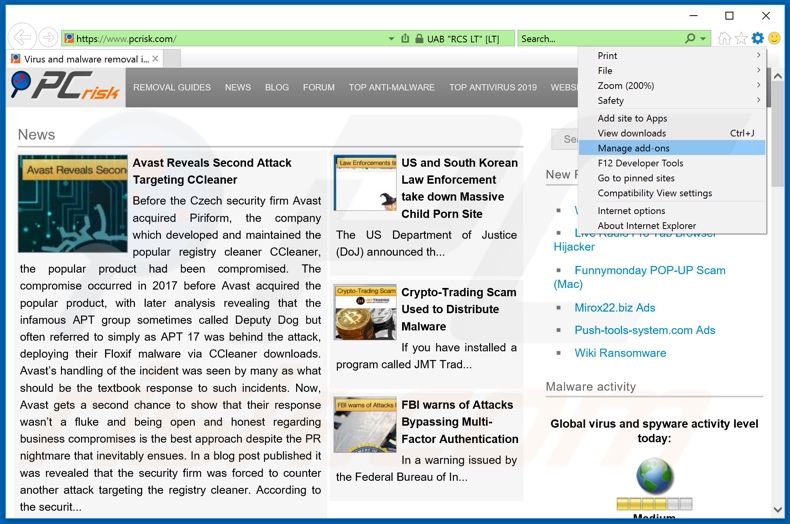
Click the "gear" icon ![]() (at the top right corner of Internet Explorer), select "Manage Add-ons". Look for any recently-installed suspicious browser extensions, select these entries and click "Remove".
(at the top right corner of Internet Explorer), select "Manage Add-ons". Look for any recently-installed suspicious browser extensions, select these entries and click "Remove".
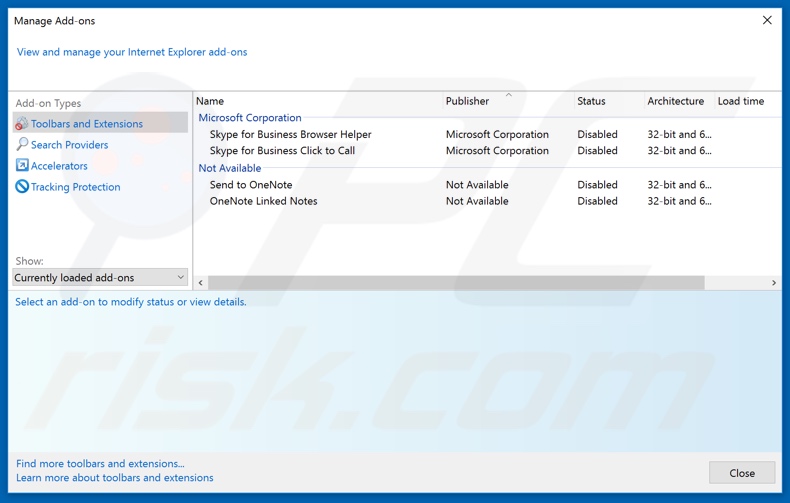
Optional method:
If you continue to have problems with removal of the the pc power potentially unwanted application, reset your Internet Explorer settings to default.
Windows XP users: Click Start, click Run, in the opened window type inetcpl.cpl In the opened window click the Advanced tab, then click Reset.

Windows Vista and Windows 7 users: Click the Windows logo, in the start search box type inetcpl.cpl and click enter. In the opened window click the Advanced tab, then click Reset.

Windows 8 users: Open Internet Explorer and click the gear icon. Select Internet Options.

In the opened window, select the Advanced tab.

Click the Reset button.

Confirm that you wish to reset Internet Explorer settings to default by clicking the Reset button.

 Remove malicious extensions from Google Chrome:
Remove malicious extensions from Google Chrome:
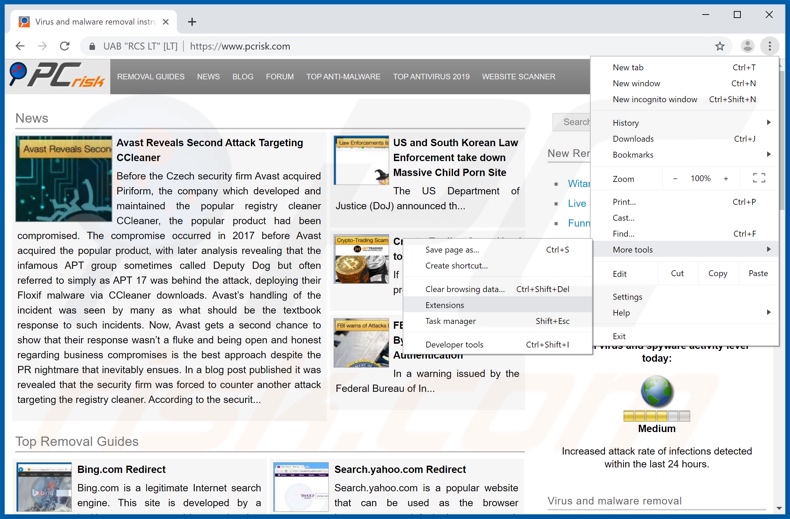
Click the Chrome menu icon ![]() (at the top right corner of Google Chrome), select "More tools" and click "Extensions". Locate all recently-installed suspicious browser add-ons and remove them.
(at the top right corner of Google Chrome), select "More tools" and click "Extensions". Locate all recently-installed suspicious browser add-ons and remove them.
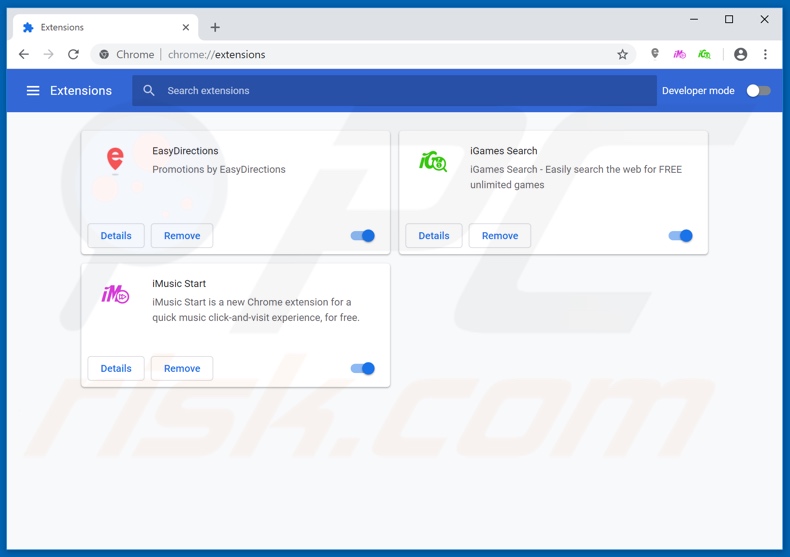
Optional method:
If you continue to have problems with removal of the the pc power potentially unwanted application, reset your Google Chrome browser settings. Click the Chrome menu icon ![]() (at the top right corner of Google Chrome) and select Settings. Scroll down to the bottom of the screen. Click the Advanced… link.
(at the top right corner of Google Chrome) and select Settings. Scroll down to the bottom of the screen. Click the Advanced… link.

After scrolling to the bottom of the screen, click the Reset (Restore settings to their original defaults) button.

In the opened window, confirm that you wish to reset Google Chrome settings to default by clicking the Reset button.

 Remove malicious plug-ins from Mozilla Firefox:
Remove malicious plug-ins from Mozilla Firefox:
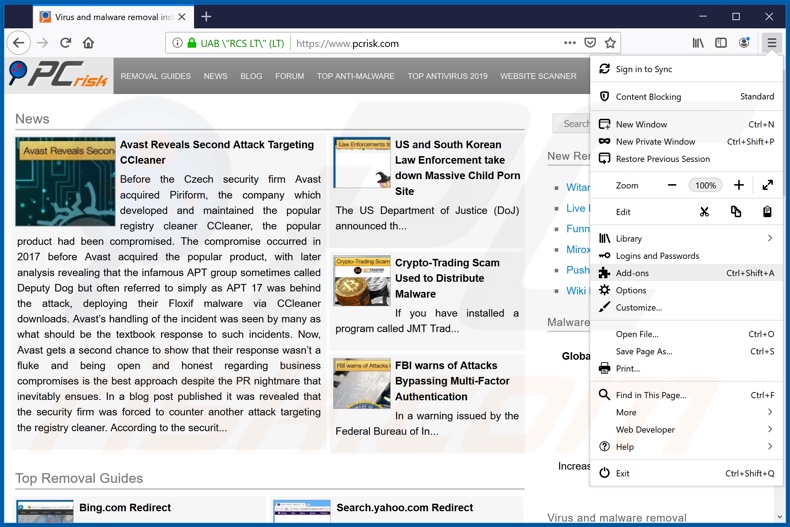
Click the Firefox menu ![]() (at the top right corner of the main window), select "Add-ons". Click on "Extensions", in the opened window, remove all recently-installed suspicious browser plug-ins.
(at the top right corner of the main window), select "Add-ons". Click on "Extensions", in the opened window, remove all recently-installed suspicious browser plug-ins.
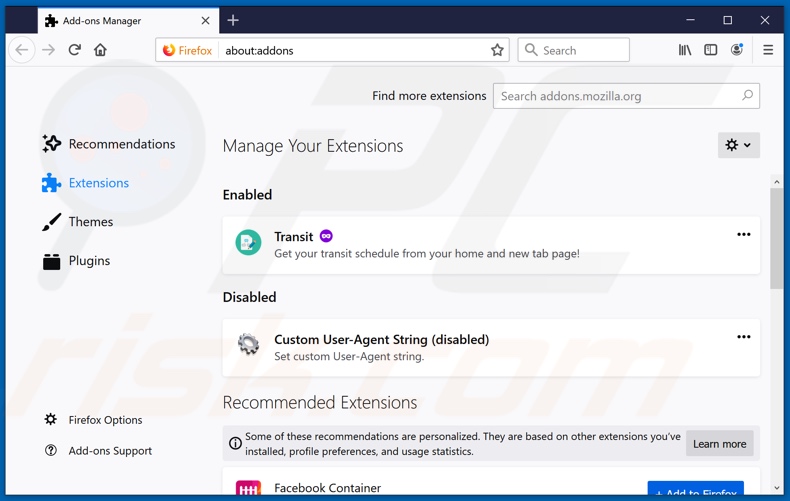
Optional method:
Computer users who have problems with the pc power potentially unwanted application removal can reset their Mozilla Firefox settings.
Open Mozilla Firefox, at the top right corner of the main window, click the Firefox menu, ![]() in the opened menu, click Help.
in the opened menu, click Help.

Select Troubleshooting Information.

In the opened window, click the Refresh Firefox button.

In the opened window, confirm that you wish to reset Mozilla Firefox settings to default by clicking the Refresh Firefox button.

 Remove malicious extensions from Safari:
Remove malicious extensions from Safari:

Make sure your Safari browser is active, click Safari menu, and select Preferences....

In the opened window click Extensions, locate any recently installed suspicious extension, select it and click Uninstall.
Optional method:
Make sure your Safari browser is active and click on Safari menu. From the drop down menu select Clear History and Website Data...

In the opened window select all history and click the Clear History button.

 Remove malicious extensions from Microsoft Edge:
Remove malicious extensions from Microsoft Edge:

Click the Edge menu icon ![]() (at the upper-right corner of Microsoft Edge), select "Extensions". Locate all recently-installed suspicious browser add-ons and click "Remove" below their names.
(at the upper-right corner of Microsoft Edge), select "Extensions". Locate all recently-installed suspicious browser add-ons and click "Remove" below their names.

Optional method:
If you continue to have problems with removal of the the pc power potentially unwanted application, reset your Microsoft Edge browser settings. Click the Edge menu icon ![]() (at the top right corner of Microsoft Edge) and select Settings.
(at the top right corner of Microsoft Edge) and select Settings.

In the opened settings menu select Reset settings.

Select Restore settings to their default values. In the opened window, confirm that you wish to reset Microsoft Edge settings to default by clicking the Reset button.

- If this did not help, follow these alternative instructions explaining how to reset the Microsoft Edge browser.
Summary:
 Commonly, adware or potentially unwanted applications infiltrate Internet browsers through free software downloads. Note that the safest source for downloading free software is via developers' websites only. To avoid installation of adware, be very attentive when downloading and installing free software. When installing previously-downloaded free programs, choose the custom or advanced installation options – this step will reveal any potentially unwanted applications listed for installation together with your chosen free program.
Commonly, adware or potentially unwanted applications infiltrate Internet browsers through free software downloads. Note that the safest source for downloading free software is via developers' websites only. To avoid installation of adware, be very attentive when downloading and installing free software. When installing previously-downloaded free programs, choose the custom or advanced installation options – this step will reveal any potentially unwanted applications listed for installation together with your chosen free program.
Post a comment:
If you have additional information on the pc power potentially unwanted application or it's removal please share your knowledge in the comments section below.
Share:

Tomas Meskauskas
Expert security researcher, professional malware analyst
I am passionate about computer security and technology. I have an experience of over 10 years working in various companies related to computer technical issue solving and Internet security. I have been working as an author and editor for pcrisk.com since 2010. Follow me on Twitter and LinkedIn to stay informed about the latest online security threats.
PCrisk security portal is brought by a company RCS LT.
Joined forces of security researchers help educate computer users about the latest online security threats. More information about the company RCS LT.
Our malware removal guides are free. However, if you want to support us you can send us a donation.
DonatePCrisk security portal is brought by a company RCS LT.
Joined forces of security researchers help educate computer users about the latest online security threats. More information about the company RCS LT.
Our malware removal guides are free. However, if you want to support us you can send us a donation.
Donate
▼ Show Discussion